It's time to start rolling up characters using the new and revised rules found in the 2024 Player's Handbook! Character creation rules have been streamlined and rearranged in the new Player's Handbook, making it easier to create your next favorite adventurer using the many player options found in the core rulebook.
In this article, we’ll explore how the character creation process has changed—and show you how to put it all into practice using the D&D Beyond Character Builder, fully updated for the 2024 rules!
- What Goes into Creating a Character?
- Step 1: Choose Your Class
- Step 2: Determine Origin
- Step 3: Determine Your Ability Scores
- Step 4: Choose an Alignment
- Step 5: Fill in Details
The 2024 Player’s Handbook is Now Available!
Buy the 2024 Player's Handbook today and dive into revised rules, enhanced character options, and exciting gameplay innovations.
Get your copy on the D&D Beyond marketplace and seamlessly integrate your new content with D&D Beyond's library of digital tools built to make D&D easier, so you can focus on the fun!
What Goes into Creating a Character?
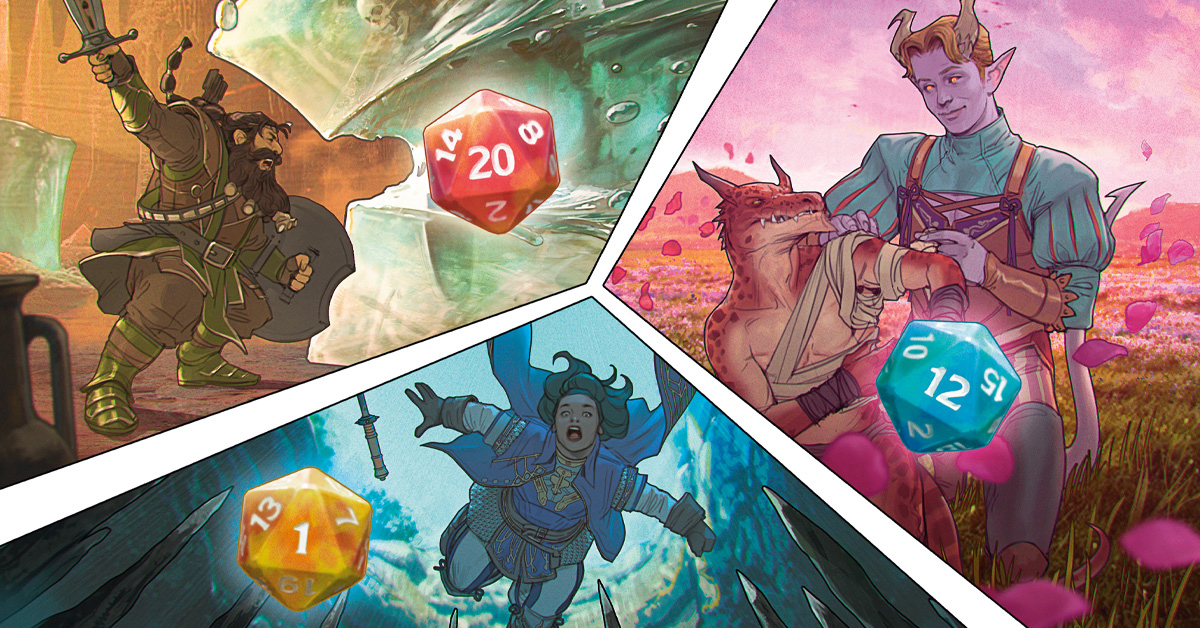
Throughout your character's adventuring career, they'll be faced with many choices. Will they save the village from the dragon, even if it means risking their own life? Will they wield a Greatsword or Greataxe? Will they adopt one of the Goblin brigands who attempted to waylay them on the road?
However, before they can embark on their career, you have a few choices of your own to make. During character creation, these four aspects will impact how your character operates on a mechanical level:
- Character class: Your character's class is your most mechanically significant aspect. It provides features that, as you level up, dictate how you will approach situations. Rogues may stealth into a situation, Wizards might use their magic to outsmart their opponents, and Barbarians might kick down the door and start swinging. We cover each of the revised classes and their accompanying subclasses in our 2024 Player's Handbook class reviews.
- Background: While your species represents who you descended from, your background represents your most formative experiences. Mechanically, this gives your character skill and tool proficiencies and starting equipment. In the 2024 Player's Handbook, your background also includes ability score adjustments, which used to be tied to your species. In addition, it now provides an Origin feat, a boon dictated by the skills you developed before your adventuring career began.
- Species: Your species represents your character's heritage. Were you born to a human family living in Baldur's Gate? Or a dwarven clan dwelling beneath the Crystalmist Mountains? Mechanically, this provides abilities that were passed down by your ancestors. The Elf's Fey Ancestry is an example of such an innate ability, representing their capability to overcome beguiling magic because of the time their ancestors spent in the Feywild.
- Ability scores: Every character is different. Even Human Barbarians from the same clan excel in different areas. Ability scores define your character's strengths (and weaknesses) in a matrix represented by Strength, Dexterity, Constitution, Intelligence, Wisdom, and Charisma.
Besides these mechanical aspects, your character will also have more personal and intangible qualities. They will have developed a backstory, personality, and alignment. They may have a cherished pet or a food they despise. While these might not affect what type of dice you roll to attack, they're just as important for deciding how your character will react to the various situations they'll encounter on their travels.
Let's Create a Character from the 2024 Player's Handbook
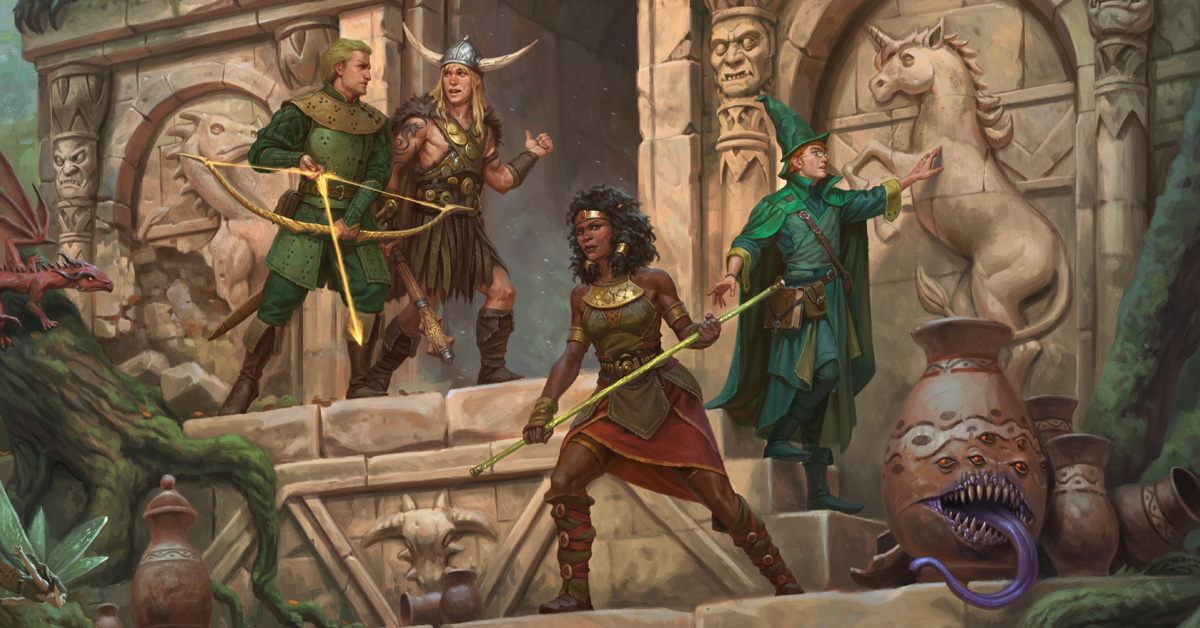
For our example character, we're going to build a level 1 Dwarf Fighter named Angriff. We'll walk through each of the steps presented in the 2024 Player's Handbook in order, and provide the rationale for how we made the choices when we were presented with options.
Step 1: Choose Your Class
Time to fire up the Character Builder!
Previously, character creation started with choosing your species. Now, we start by choosing our character class. This is because your class is the culmination of your character's origin; it shows where they wound up at the start of their adventuring career. It's also important to establish your class first because it impacts certain choices you make when choosing your species and background—like what ability scores you're looking to improve with your background.
This decision will impact how your character plays for their entire adventuring career. Luckily, the Class Overview table in Chapter 2 provides a breakdown of what each class specializes in, what ability score they usually focus on, and how hard they are to navigate as a player.
So, when we choose the Fighter class, we'll note what they receive at level 1 on our character sheet:
Core Traits
Each class now has a handy table of the core traits you receive when you choose them at level 1. Here are the choices we've made for Angriff:
- Primary ability: Strength — This first trait just serves as a reminder of what your class wants to focus on. Between Dexterity and Strength, our Fighter will be opting for Strength.
- Hit Point Die: D10 — This represents what we roll when we increase our number of Hit Points and regain them during a Short Rest. Once we figure out our ability scores in Step 3, we'll apply this to our starting Hit Point maximum.
- Saving Throw Proficiencies: Strength and Constitution — As a Fighter, we get to add our Proficiency Bonus to these saving throws.
- Skill Proficiencies: Persuasion, Perception — These are the skills we want our Fighter to have a boost in. When we make ability checks using these skills, we get to add our Proficiency Bonus.
- Weapon Proficiencies: Simple and Martial weapons — Fighters don't have any restrictions over which weapons they can wield effectively. Any weapon you pick up and swing at an enemy, you can add your Proficiency Bonus to the roll.
- Armor Training: Light, Medium, and Heavy armor and Shields — Likewise, Fighters can wear any type of armor they want without any downsides (as long as they meet the Strength requirements for Heavy armor).
- Starting Equipment: Chain Mail, Greatsword, Flail, 8 Javelins, Dungeoneer's Pack, and 4 GP — We're suiting up for a Heavy armor Strength-based Fighter, so this is the ideal kit to start with.
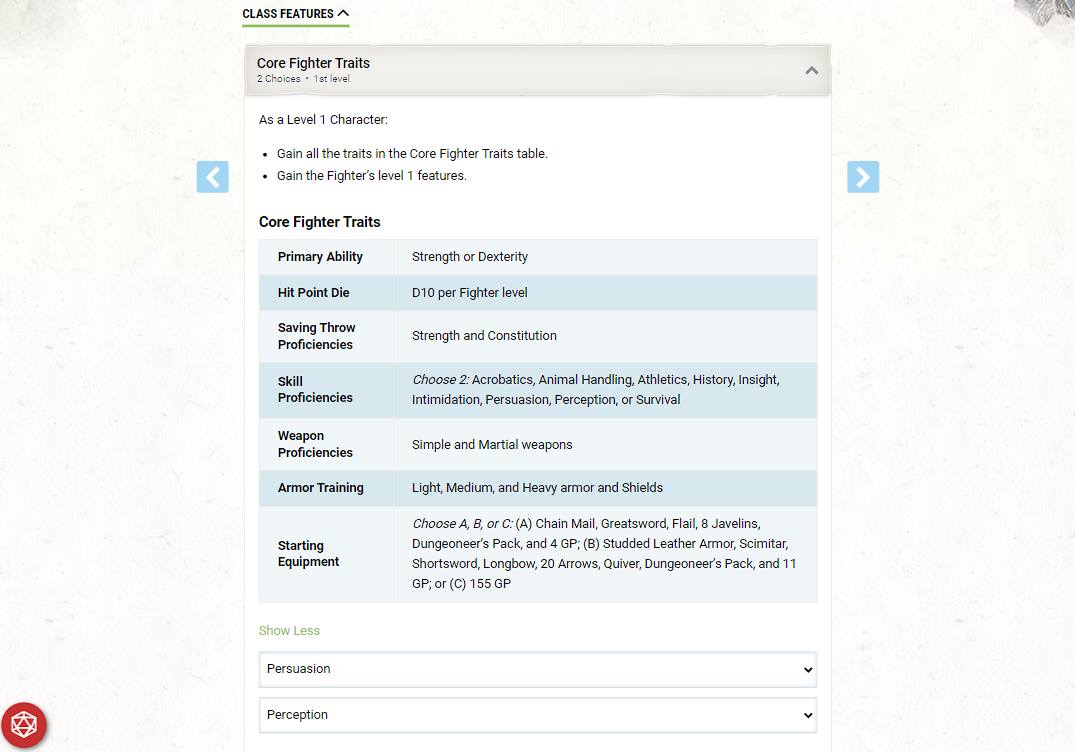
Fighting Style
We get to choose a Fighting Style feat at level 1. Previously, the Fighter's Fighting Styles were listed in their class features rather than being separated out into feats. In the 2024 Player's Handbook, these feats have a prerequisite of needing the Fighting Style class feature.
This doesn't change much, only that the different classes that have the Fighting Style are no longer limited in their choices. Some Fighting Styles used to be exclusive to certain classes and the globalized list has lifted those restrictions.
We're choosing the Great Weapon Fighting feat, which allows us to treat any 1 or 2 on a damage dice as a 3 as long as we're attacking with a Two-Handed or Versatile weapon.
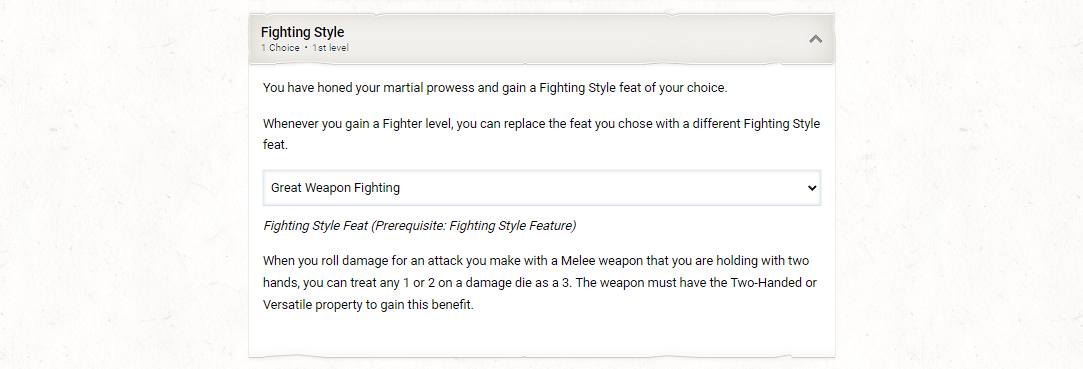
Second Wind
If all that fighting leaves you out of breath (or on the brink of death), worry not. Fighters get the Second Wind feature! This allows you to regain Hit Points equal to 1d10 plus your Fighter level as a Bonus Action. You start with 2 uses and can regain one when you finish a Short Rest or all of your expended uses after a Long Rest.
These Second Wind uses can also be applied to other Fighter features as you level up, like Tactical Mind and Tactical Shift, but let's not get ahead of ourselves.

Weapon Mastery
Now for the Fighter's first all-new feature, Weapon Mastery! This allows your Fighter to learn three weapons' mastery properties and to use them when they wield those weapons in combat. Because our loadout came with a Greatsword, Flail, and Javelin, we'll take these as our chosen weapons.
This means we can access the Graze mastery property with our Greatsword, the Sap property with our Flail, and the Slow property with our Javelin.
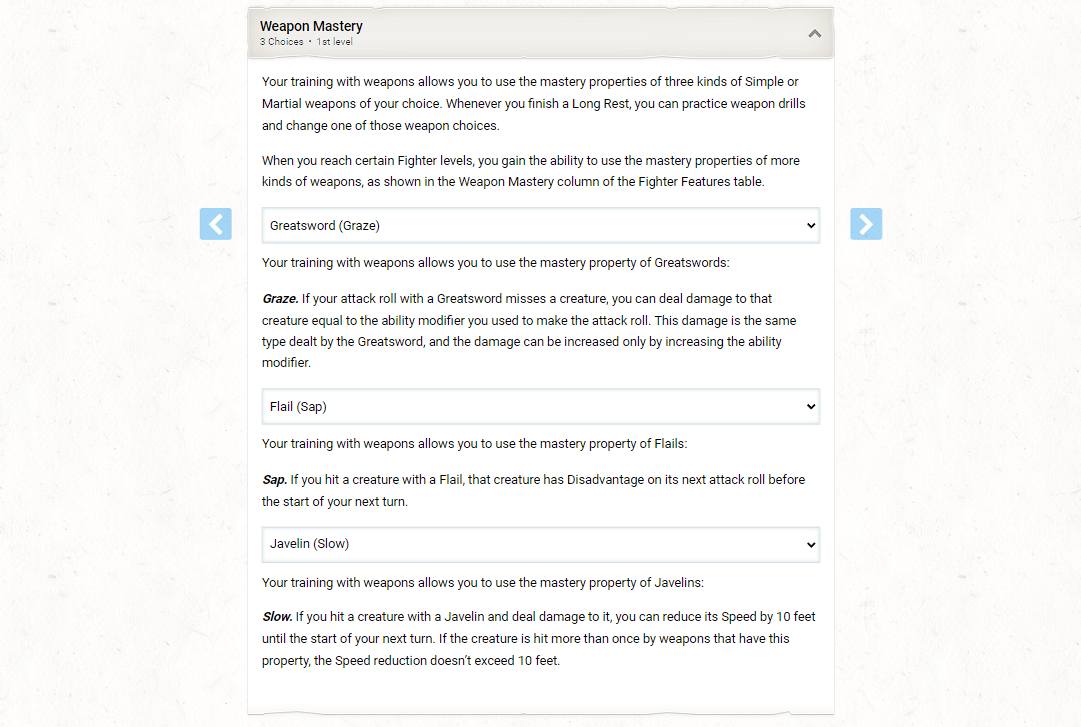
Step 2: Determine Origin
So, our Fighter's got some skills, but where did he come from? Let's pick our background and species to help support the playstyle and narrative we're trying to achieve.
Background
First up, we'll choose our background. As we're trying to synergize with our Fighter class, we'll choose a background that has applicable Ability Score Increases as well as an Origin feat that suits our needs.
The Soldier is an easy choice here, as it allows us to increase our Strength and Constitution, gives us applicable skill proficiencies, and a useful Origin feat:
- Ability Scores: +2 Strength, +1 Constitution — We want our Fighter to hit hard as well as be able to take hard hits, so this is a perfect boost to his stats. When we decide our ability scores in Step 3, we'll add these to our results.
- Feat: Savage Attacker — This allows us to roll our weapon's damage dice twice and take the higher of the two, perfect for squeezing out extra damage.
- Skill Proficiencies: Athletics, Intimidation — When diplomacy fails, now you can scare your enemies into listening or just put them in a full nelson.
- Tool Proficiency: Dragonchess — Checkmate. Your move.
- Equipment: 50 GP — We collected all the equipment we needed to behead our enemies in our class equipment, so let's take the money and run.

Species
Here we're going to choose the Dwarf species. These stout, stubborn, subterranean dwellers may be 4 feet tall, but they're thick enough to make up for it!
- Darkvision — This allows us to see in the dark without a light source, albeit in shades of grey. Make sure you remind your Dungeon Master you have Darkvision the second you walk into an unlit chamber.
- Dwarven Resilience — Resistance to Poison damage and Advantage on saving throws against the Poisoned condition are both excellent abilities to keep your Fighter in ship shape.
- Dwarven Toughness — You get 1 additional Hit Point at each level, including at level 1. Perfect for our frontline Fighter! We'll make sure we include this in our calculation after we've decided on our ability scores.
- Stonecunning — Adding to your array of senses, Stonecunning in the 2024 Player's Handbook allows you to gain Tremorsense to a range of 60 feet for 10 minutes. You have to be on or touching a stone surface to activate this ability, so no one will judge you for carrying around a seeing-eye pet rock.
- Language — You start with Common and one language of your choice. We'll grab Dwarvish and say that Angriff took a semester abroad at an elven grove and picked up Elvish.
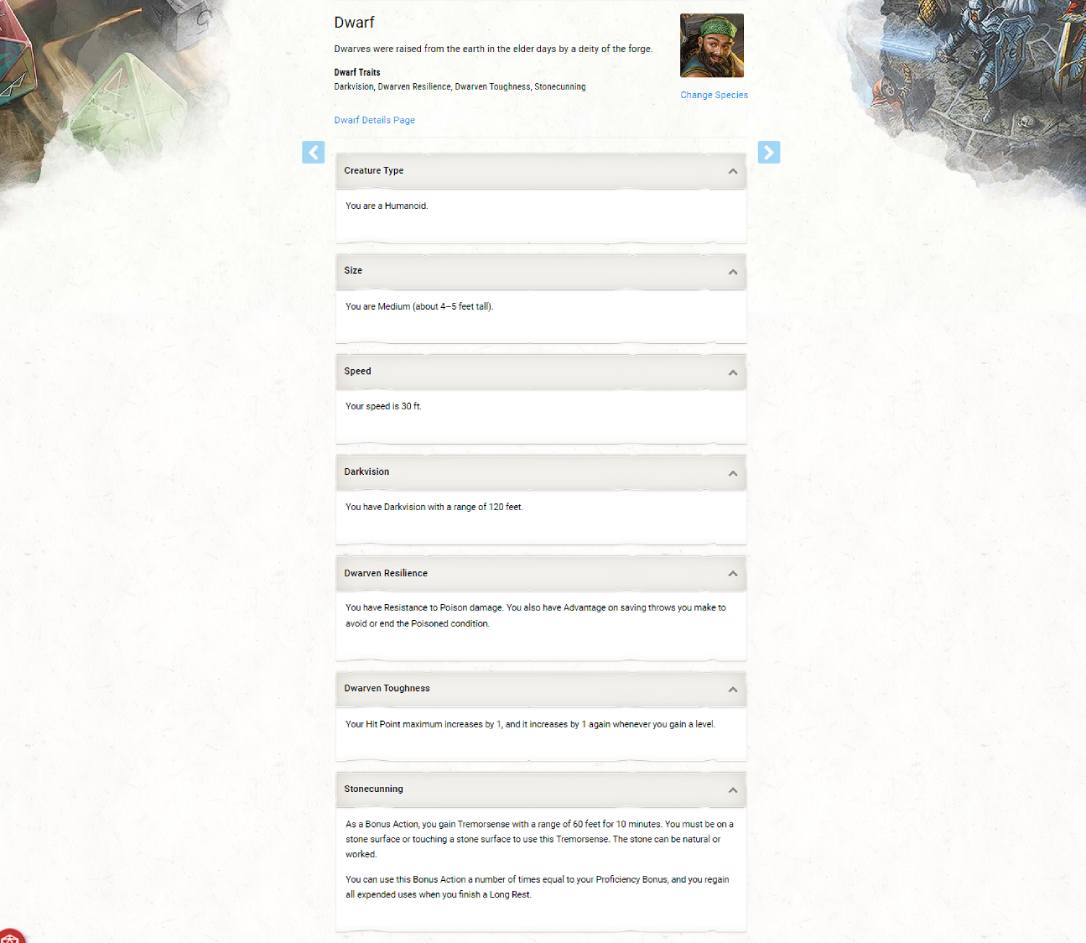
Using Backgrounds and Species from Older Sources
If you want to use an older character origin option, no problem! The 2024 Player's Handbook has rules for converting these options to be compatible with the new ruleset.
For your species, ignore any Ability Score Increases the older species you chose provides.
For your background, increase one score of your choice by 2 and another by 1, or increase three scores by 1. Also, if your background doesn't provide a feat, grab an Origin feat of your choice.
Step 3: Determine Your Ability Scores
Now that the foundation for our Dwarf Fighter has been laid, it's time to start fleshing out his abilities.
In the 2014 Player's Handbook, ability scores used to be decided before a character's background, but this was switched as backgrounds now provide a mechanically significant ability score boost.
There are still three methods for generating your ability scores: Standard Array, Random Generation, and Point Cost. For our character, we'll be using Standard Array, which gives us six scores that we assign to each of our six abilities.
For Angriff, our ability scores are as follows:
- Strength: 15 + 2 = 17 (+3) — We make attack rolls and deal damage with our Strength, so this is our highest priority. Here, we'll add the +2 from our Soldier background.
- Dexterity: 13 (+1) — Dexterity is important for sneaking, Initiative, and when a dragon's breathing fire at you—so we've filled in an above-average score here.
- Constitution: 14 + 1 = 15 (+2) —This helps dictate your Hit Points, and since we'll be on the front lines, we need those to stay up and swinging. We add our +1 from our Soldier background here.
- Intelligence: 10 (+0) — Intelligence isn't super important to our Fighter, but a bit can never hurt.
- Wisdom: 8 (-1) — Smart enough to know a tomato is a fruit but not wise enough to exclude it from a fruit salad. We've taken an 8 here because we have proficiency in Perception, our Fighter's most important Wisdom-based skill.
- Charisma: 12 (+1) — We have proficiencies in both Intimidation and Persuasion in our kit, so a +1 can help solidify these checks in social situations.
Now that we've decided on our ability scores, we can determine how they reflect our character's appearance and personality. For example, our Dwarf looks like a gruff, battle-hardened warrior but he's surprisingly charming and light on his feet.
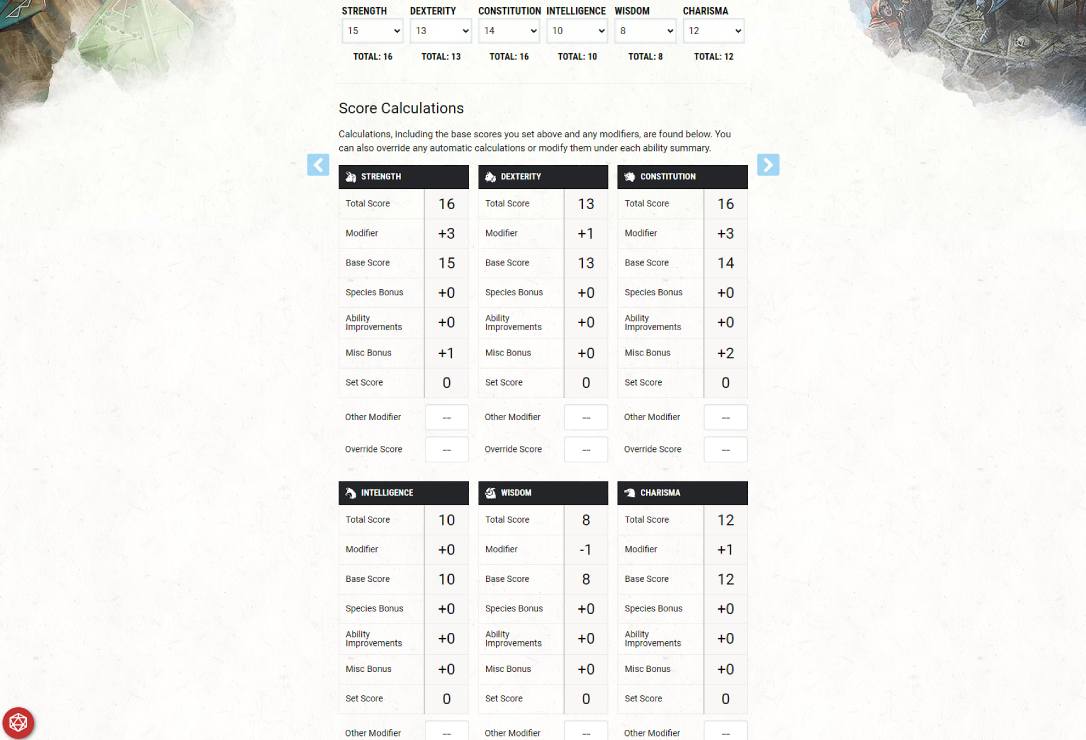
Step 4: Choose an Alignment
With our ability scores, class, background, and species decided on, we're almost ready to fill in the remaining details of our character sheet. Just one pit stop before we do.
We need to decide on our character's alignment, which reflects their moral and ethical compass. Are they Lawful Good, always striving to uphold justice? Or Chaotic Neutral, following their whims regardless of what the City Watch—or the tyrannical king's henchmen—may have to say? We're choosing Neutral Good for our Dwarf Fighter.
On D&D Beyond's Character Builder, alignment can be chosen by going back to the Background step:

Step 5: Fill in Details
If you're playing with pen and paper, now it's time to bust out that calculator—or wish we took a high Intelligence score. Luckily D&D Beyond's Character Builder does all the work for you! No need to make sure your saving throws, skills, and attack bonuses are applying the proper modifiers, it's all done automatically.
Now, we're ready to strike out on our quest to save the world!
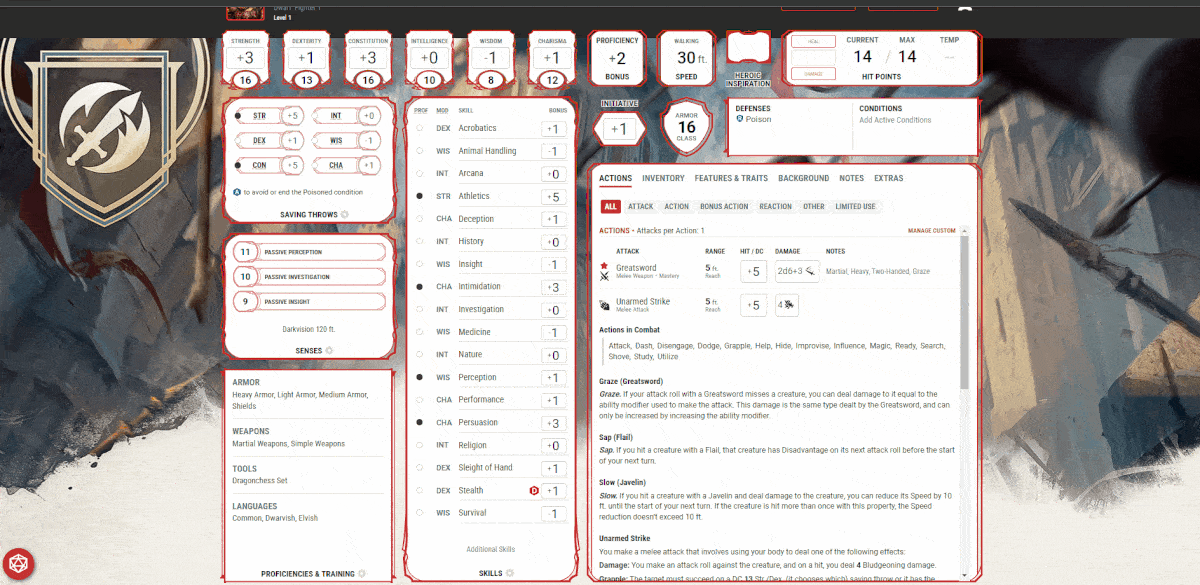
Adventure On, Adventurer!
The 2024 Player's Handbook is now available on the D&D Beyond marketplace, which means it's time to set out on new adventures with fresh or familiar characters!
So, while some steps have been switched around and some aspects have been shifted to different options, character creation is still a familiar process in the 2024 Player's Handbook. However, with this new process, you'll make choices in a more sensical progression. Seeing as you choose your character's class first, you can look at their origin with the perspective, "How did my character become a Fighter?" This also allows you to ensure that the species, background, and ability scores you choose are synergistic to the character you'll be rolling dice with.
We’re delighted to share with you the changes to fifth edition D&D that appear in the 2024 Player’s Handbook. Make sure to keep an eye out on D&D Beyond for more useful guides on using the wealth of new options, rules, and mechanics found in the 2024 Player's Handbook!

Mike Bernier (@arcane_eye) is the founder of Arcane Eye, a site focused on providing useful tips and tricks to all those involved in the world of D&D. Outside of writing for Arcane Eye, Mike spends most of his time playing games, hiking with his partner, and tending the veritable jungle of houseplants that have invaded his house.








-
View User Profile
-
Send Message
Posted Aug 10, 2024YES! I have the essentials kit and I was wondering if you would get a free revised basic rules and some new character sheets.
-
View User Profile
-
Send Message
Posted Aug 10, 2024H
-
View User Profile
-
Send Message
Posted Aug 10, 2024Hence my concern
-
View User Profile
-
Send Message
Posted Aug 10, 2024Nope. The general gist of it is if you have a 2024 rulebook, it replaces the previous versions. So you can't for example use a 2014 warlock with a 2024 subclass. If you play with the new stuff, then you use the new stuff. If it exists in the PHB (as it does with Celestial, Fiend, all those) then it replaces the 2014 ones.
It is assumed from interviews that if you're playing with a 2024 character, you use 2024 rules. And if there is a subclass that predates the 24PHB, such as Genie, then you move the subclass to level 3 and call it a day (whether or not the expanded spells turn into free permanent listed spells is unknown but I imagine a DM would assume its stupid that there's no rule for it and just give you the spells for free anyway).
-
View User Profile
-
Send Message
Posted Aug 11, 2024You know people don't like ads right?
-
View User Profile
-
Send Message
Posted Aug 11, 2024i think they forgot to mention the language you gain in the background,. The backgrounds in the 2014 PB, you would get 2 skill profeciencies, and then either 2 tool/vehicle/gaming/instrument profeciencies; 2 languages; or 1 language and one tool/vehicle/gaming/instrument profeciency. he had 1 tool, the dragon chess, but no other "tool" profeciency, so by my earlier logic, he should then gain an additional language, which is why he gets 2 languages in the species section rather than only 1. now why they didn't take dwarvish, either they just wanted to show that you don't have to conform to the steriotype of species knowing their ancestrial language, or they were failing in their studies
-
View User Profile
-
Send Message
Posted Aug 11, 2024You don't get languages from your background anymore. That's also where I'm confused. No one covering the PHB has said where you get your language from, that I've seen. This article says your species, but that's true as far as I can tell.
-
View User Profile
-
Send Message
Posted Aug 11, 2024I would like CR to be equivalent to a player character of the same level. That way you know a character of 5th level is equal to a CR5 monster. If you have a party of 4, you need 4 monsters of the same level to have a 50-50 contest.
-
View User Profile
-
Send Message
Posted Aug 11, 2024Indeed, an apples-to-apples comparison. But both (1-on-1 and team CR) would be helpful.
-
View User Profile
-
Send Message
Posted Aug 11, 2024Step 1: pick up a few darts, close your eyes, and throw them at random pages in the Character Creation section of the new Player's Handbook.
Congratulations! You've successfully built a character that can fill any role you want.
You don't create equality by toning down individuality and giving everyone extra abilities, WotC. Classes are specialized for specific roles so you don't have everyone who can do everything on their own like what these new classes are like. If barbarians are also good healers, and wizards are also good tanks, what's the point of having a party? It's a cooperative roleplaying game, not a power fantasy roleplaying game. In that same vein, dwarves are hardier than elves, and gnomes are better craftsmen than half-orcs. These racial differences ("species" makes them sound like things to be studied, and not people with sentience) are what makes both character builds and roleplay easier and more interesting. Even worse, where are all the different subraces? It looks like they've all been absorbed into their races and given even more abilities on top of that, which is both boring and a way to create OP characters from level 1. All dwarves get resistance to poison and disease and extra HP at every level and tremorsense? That's broken, and that's before the free feats and abilities being given out with backgrounds. Feats are something you work hard for. If you've already accomplished enough to gain a feat, you shouldn't still be at level 1. That's literally an isekai cheat ability. Either this whole thing needs to be scrapped and reworked, or you're going to have a lot of faceless problem players who think they're consequence-free gods because they basically are, and that'll only hurt your precious brand image.
-
View User Profile
-
Send Message
Posted Aug 11, 2024It's likely because since subspecies are more or less disappearing not to mention innate weapon and skill proficiencies related to culture (exceptions such as elves with their keen senses and bugbears being fey boogymen so stealth makes sense there) are being done away with so makes sense to roll in most of the subspecies features in, especially if they're like minute ones such as the lightfoot halfling feature of being able to hide behind a larger creature. Stonecunning 2014 was situational and largely useless so it was either axe the ability completely or give them something new. Tremorsense is new and shows off the more dwarvish ability rather than something miniscule as a weapon proficiency or armour in terms of mountain dwarf. I'd scrap it too and give all dwarves +1 to HP if it meant showing off more of what a dwarf can do.
More racial abilities are a better way of showing off what that species can do rather than whatever minor thing existed before. All dwarves got resistance to poison even back in 2014 so its not broken there, and people have done the math and calculations with tremorsense. It's situational but better than what it was before. Duergar got both resistance to poison and advantage on getting rid of charmed and stunned conditions. So its not broken at all and lines up with what we already know of.
Feats on the other hand have been put into backgrounds for awhile, starting from Spelljammer to now, and barring setting specific ones like Dragonlance and Planescape and the Bigby's book, they all have complied with the new Origin feats put out there. The only difference now is that they have hardcoded the house rule of "everyone gets a free level 1 feat" that everyone liked when it was present. And I'll cheat a little here, they have said that if your a veteran player you may as well start at level 3, so in actuality you're getting a level 3 feat, two if you're human before getting a new half feat at level 4.
And think of it this way, it fixes the age old problem of "oh I did all these things in my life (be a general or a magic teacher) and yet I am only a level 1 character in actual play." So now you get a free feat that should in some fashion represent what your character did in their life.
No one is really that much more overpowered, its more that the ceiling has been raised up and the new powerscaling is the new norm, especially since all the monsters in the new MM will be adjusted to fit their CR better.
-
View User Profile
-
Send Message
Posted Aug 11, 2024A majority of the game is stats. Besides they still have the back ground area and PBIF is something you can write down in a journal or keep in your head. It took up way too much space.
-
View User Profile
-
Send Message
Posted Aug 11, 2024Why is it wrong to have a dwarf who doesn't speak dwarvish? There are thousands of people who are one ethnicity and cant speak their own language...
-
View User Profile
-
Send Message
Posted Aug 11, 2024Where did I say it was "wrong"? I just find it very funny, especially since they made 0 effort in this "example" to explain it in any way lol. They explained the other two languages with one sentence each (though not sure where the gnomish appeared from, considering it's supposed to be common +1 extra), but nothing about why the dwarf, who presumably still lives underground with other dwarves considering the explanation for gnomish, cannot speak his native language.
-
View User Profile
-
Send Message
Posted Aug 11, 2024FREE up to date 64 page rulebook for essential kit from WotC will cost you more than the original box. Look at all the 32 pages of shiny paper they need to reprint!!
-
View User Profile
-
Send Message
Posted Aug 12, 2024I think for now I'm sticking with 5e 2014. Not crazy about attribute bonuses from backgrounds.
-
View User Profile
-
Send Message
Posted Aug 12, 2024So basically what's said is the fact that I'm made of steel doesn't make me able to take more blows. Wow.
Or I can take so much despite my kin being generally weak to attacks. Yay!
-
View User Profile
-
Send Message
Posted Aug 12, 2024Xanimal said on Page 2 that there appears to be an error, because it was two extra languages in the playtest.
-
View User Profile
-
Send Message
Posted Aug 12, 2024Clearly Dragonchess has different rules than Chess.
-
View User Profile
-
Send Message
Posted Aug 12, 2024Thief is invisible then...